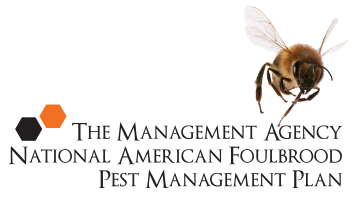Drift
Bees drifting between hives
Bees drift from one hive to another, particularly when hives are set out in straight lines, when they are all painted the same colour, or when the entrances of hives are placed close together.
The drifting of bees between hives is often mentioned as a major factor in the spread of AFB. Beekeepers cite examples where if one hive develops AFB, the one next to it will also develop AFB. However, there are many more examples where this does not happen, so coincidence cannot be ruled out.
The hive next to a hive infected with AFB will usually be the next one worked by the beekeeper, and if hive parts are intentionally or inadvertently moved between hives, they are most likely to end up in the hive next to the one with AFB. It is therefore very difficult to be sure whether a hive developed AFB through drift or from other means.
Experimentation undertaken to understand drifting as a factor in the spread of AFB
Trials have been conducted to determine whether bees drifting from hives with low level AFB infections (less than 50 larvae/pupae exhibiting disease symptoms) are likely to spread AFB. Hives with low-level infections are the kind that a beekeeper is most likely to miss.
A total of 24 pairs of hives were set up, each pair consisting of one hive with a light AFB infection and one uninfected hive. The hives in each pair were facing the same way and positioned as close together as possible in order to maximise the level of drift.
The findings
When the level of drift between the hives was checked, it was estimated that the equivalent of 50% of the bees had swapped hives over a 20-day period. However, this may have been because of a smaller number of bees moving backwards and forwards between hives several times, rather than 50% of the bees swapping hives.
The pairs of hives were together for a total time of seven years (an average of 103 days for each pair). Only two of the non-infected control hives developed AFB. Both hives developed AFB at the same time that 12 other hives in two apiaries involved in another experiment close by also developed AFB. It is possible that the infection in these two non-infected colonies could have been because of robbing.
What is obvious, however, is that since only 8% of the control hives developed AFB, bees drifting from hives with light AFB infections cannot be considered to be a major factor in the spread of AFB. Whether the same can be said for drift from colonies with heavy infections is unknown.
Even if drift is not an important means of spread of AFB, care should still be taken to reduce it to a minimum, since excessive drifting can affect honey production.
Reducing the likelihood of drift
Three simple methods are effective in reducing drifting between hives.
These are:
- The use of irregular or non-repetitive layouts (patterns) of hives, and situating hives so they face different directions
- The use of different coloured supers
- The use of orientation marks near hives.
Since bees drifting between hives can spread AFB, beekeeping practices that minimise drift should be used.
Take the AFB 5 minute quiz
How well do you know what you need to know about AFB and beekeeping? Take our short quiz and find out.
Videos
Our videos cover everything from your legal obligations to how to recognise AFB, collecting cell and bee samples and more.
Symptoms
There’s a lot of good information here, telling you everything you need to know about recognising AFB: the visual symptoms, smell of AFB and more.
Inspection and Diagnosis
Successfully eliminate AFB by telling the difference between symptoms of AFB and other brood diseases in the hive. We tell you the best methods for inspecting your hives.
The Law
New Zealand beekeepers have a number of legal obligations that must be met regarding AFB disease. Read the shortened list in summary, here.
Elimination
Most hives become infected because bees, honey or equipment have been put into a hive from another hive that is infected with AFB. Lower your chances of an AFB infection by reading this section.
AFB Recognition Course Info
Find out when the next AFB Recognition and Competency Courses, or Refresher Courses are available. These are held throughout the year in various New Zealand locations across the South Island and North Island.
The AFB App
Follow the link below to open the App. Once open to save to your device you need to bookmark the URL on your phone so you can find it easily again. Please click here to open.









